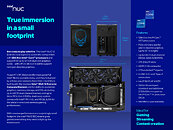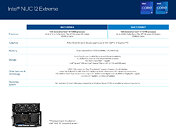- Joined
- Oct 9, 2007
- Messages
- 47,687 (7.42/day)
- Location
- Dublin, Ireland
| System Name | RBMK-1000 |
|---|---|
| Processor | AMD Ryzen 7 5700G |
| Motherboard | Gigabyte B550 AORUS Elite V2 |
| Cooling | DeepCool Gammax L240 V2 |
| Memory | 2x 16GB DDR4-3200 |
| Video Card(s) | Galax RTX 4070 Ti EX |
| Storage | Samsung 990 1TB |
| Display(s) | BenQ 1440p 60 Hz 27-inch |
| Case | Corsair Carbide 100R |
| Audio Device(s) | ASUS SupremeFX S1220A |
| Power Supply | Cooler Master MWE Gold 650W |
| Mouse | ASUS ROG Strix Impact |
| Keyboard | Gamdias Hermes E2 |
| Software | Windows 11 Pro |
Today, Intel announced the Intel NUC 12 Extreme (code-named Dragon Canyon) and the Intel NUC 12 Extreme Compute Element (code-named Eden Bay), a highly modular desktop PC kit engineered to provide phenomenal performance for high-end gaming and content creation tasks. With the latest 12th Gen Intel Core desktop processors, capacity for full-size 12-inch discrete graphics cards and a full range of I/O ports including Thunderbolt 4, the Intel NUC 12 Extreme delivers massive performance and features that enthusiast gamers and professional creators need in a compact and modular form factor.
The Intel NUC 12 Extreme brings Intel's new performance hybrid architecture and a socketed motherboard to the NUC line for the first time. For those who want a powerful system with a small footprint and more versatility than ever before, the Intel NUC 12 Extreme Kit is an outstanding option. The most powerful Intel NUC yet encompasses new features, like performance hybrid architecture and access to faster PCIe interfaces, accelerating load times, all in a footprint that can fit on any desk.




Built with flexibility in mind, the modular Intel NUC 12 Extreme Compute Element provides enthusiast gamers and creators the ability to create their own small form-factor designs, giving users the option to be creative and configure the system footprint to their liking.
The NUC 12 Extreme offers breakthrough speeds with up to a 12th Gen Intel Core i9 processor, featuring eight Performance-cores (P-cores) and eight Efficient-cores (E-cores), 24 threads and up to 5.1 GHz turbo boost max frequency.
Additional features include:
View at TechPowerUp Main Site
The Intel NUC 12 Extreme brings Intel's new performance hybrid architecture and a socketed motherboard to the NUC line for the first time. For those who want a powerful system with a small footprint and more versatility than ever before, the Intel NUC 12 Extreme Kit is an outstanding option. The most powerful Intel NUC yet encompasses new features, like performance hybrid architecture and access to faster PCIe interfaces, accelerating load times, all in a footprint that can fit on any desk.




Built with flexibility in mind, the modular Intel NUC 12 Extreme Compute Element provides enthusiast gamers and creators the ability to create their own small form-factor designs, giving users the option to be creative and configure the system footprint to their liking.
The NUC 12 Extreme offers breakthrough speeds with up to a 12th Gen Intel Core i9 processor, featuring eight Performance-cores (P-cores) and eight Efficient-cores (E-cores), 24 threads and up to 5.1 GHz turbo boost max frequency.
Additional features include:
- Intel UHD Graphics 770 (32 EU)
- Support for up to 64 GB dual-channel DDR4-3200 MHz SODIMMs
- Support for PCIe Gen 5 x16 graphics cards
- Backwards compatible with PCIe Gen 4 and Gen 3 devices
- Support for up to three PCIe Gen4 M.2 SSDs
- Two Thunderbolt 4 ports, Intel Wi-Fi 6E AX211, a 10 Gbps Ethernet port standard; and additional 2.5 Gbps Ethernet port on Intel Core i9 processor SKUs
View at TechPowerUp Main Site

